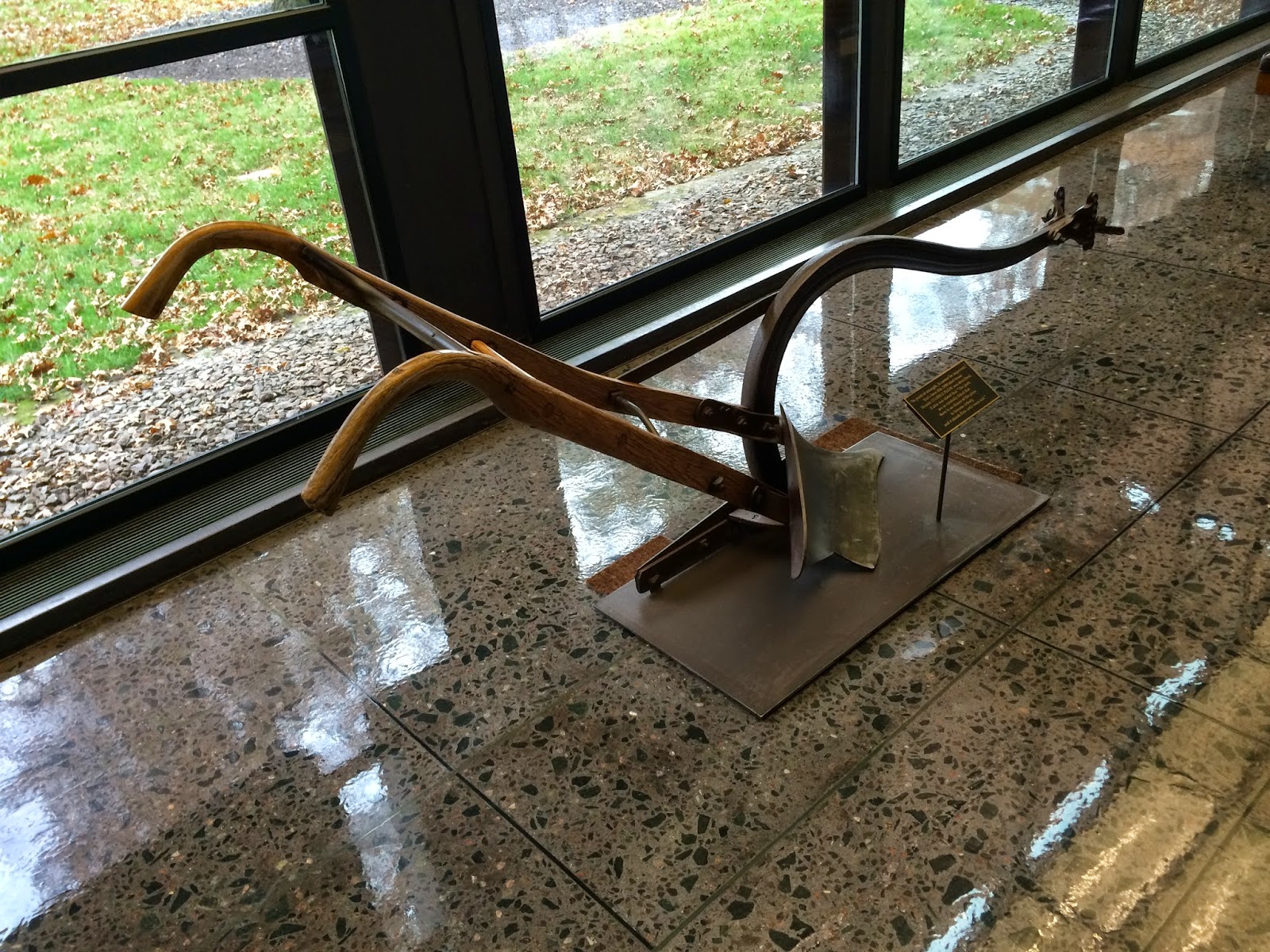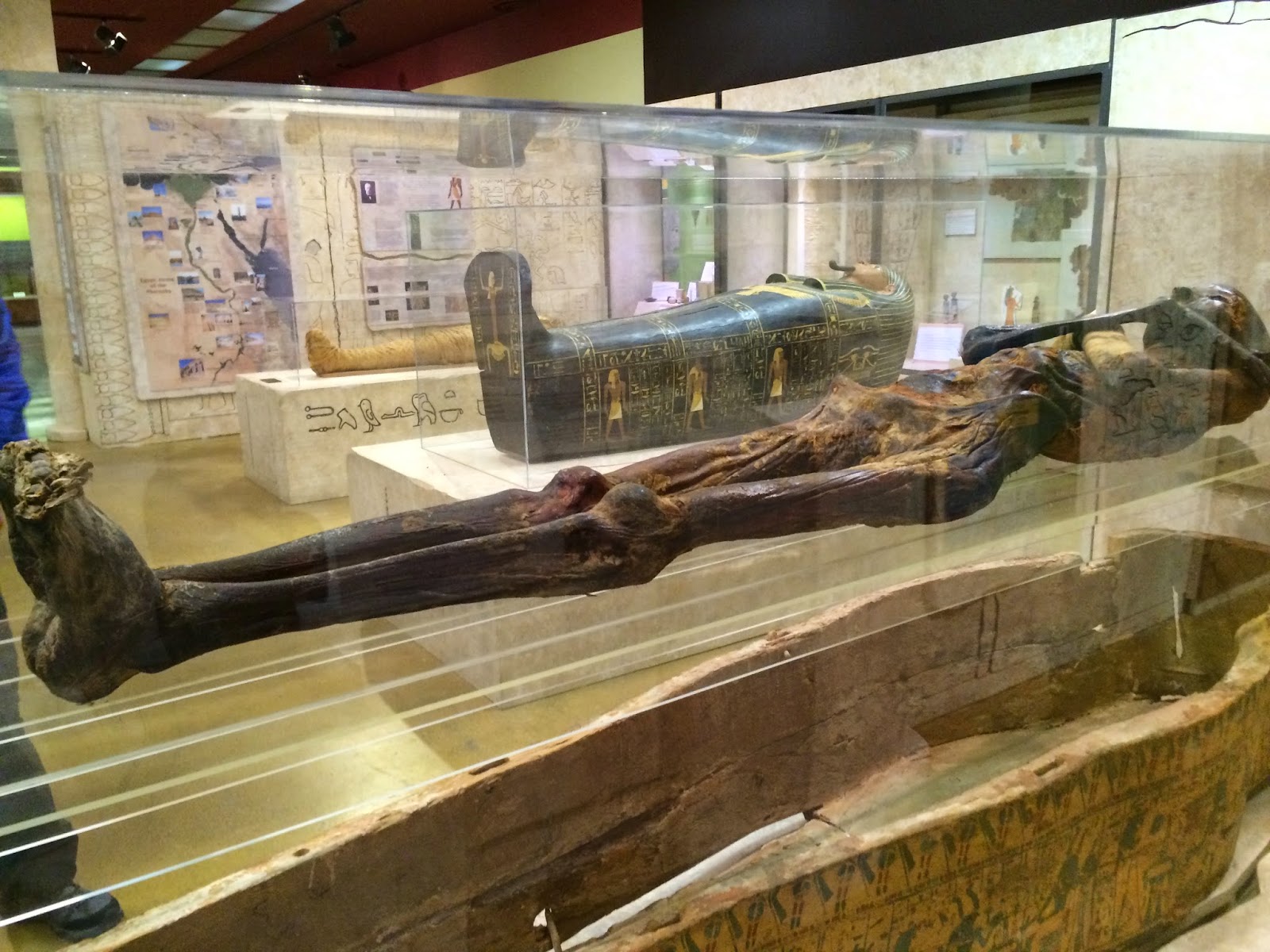John Deere, a young Vermont blacksmith, settled in Grand Detour, Illinois, in late 1836. In the following year he forged a steel plowshare from a broken saw blade. Deere's steel plow scoured! That is, it passed cleanly through the moist gumbo earth of the Illinois prairie overcoming the tendency of that rich soil to stick to the iron plowshare, a problem that forced the pioneer farmers to stop every few yards and scrape the plowshare clean.
Where other inventors of steel plows faltered, John Deere's entrepreneurial spirit, marketing skills and hard work brought him success. In 1847 he relocated his plow factory from Grand Detour to Moline where it has remained and grown into the nation's leading agricultural implement manufacturer.
The magnificent Eero Saarinen designed Headquarters building. It is in an equally magnificent setting. This is just the central part of the building. There are wings of equal size that are at the left and back side of the building.
Guess what greets visitors?
The display floor is two sided; one has heavy construction equipment and the other farm equipment.
Frederick at the controls of a road grader and front loader.
"In point of strength, it cannot be improved," that's how this 1890 steel-beam 14-inch stubble plow was described. Is also was stated that "The parts are so carefully fitted that there is no chance of the plow to become rickety, and it stands firm until worn out."
John Deere's original riding plow, the Gilpin Sulky was one of the company's most successful plows. Its great innovation was that the operator rode behind the plow rather than walking, a feature especially popular with Civil War Veterans who had lost limbs. This model, the New Deere Sulky, was produced from 1903 to 1929 and is an improvement on the Gilpin Sulky because the wood parts from the original were replaced with steel. Another important feature was that the plow bottom could be lifted by the operator's foot at the end of each furrow, enabling the rig to be easily turned around to start the next furrow while keeping his hands on the reins.
The demand for a small combine was filled with the model 45 combine above. With its introduction in 1954, John Deere created the first combine that could cut and shell the corn in one operation.
Now look at this beauty! The 606C Corn Head, available in sizes ranging from 6 to 18 rows. This model, as show, retails for approximately $54,778. It has an industry exclusive AutoTrac RowSense row guidance system; combines mechanical row sensors on the corn heads and GPS signal on the combine to provide automated steering. This innovative system automatically steers the combine through the field during harvest without the operator having to manually steer.
This thresher, Frederick is there for scale, also has the innovative GPS guided system and the approximate retail price, as shown, is $364,071,00.
A plain old tractor but with dual rear wheels (Frederick is there for scale).
Two nice swans in the pond in front of the Headquarters building.
Our next stop was at the impressive Putnam Museum in Davenport. Exhibits reflect the region's history and the archaeology of Egypt, Asia and the Americas. The museum has six permanent exhibit halls including the Hall of Mammals; River, Prairie and People (where we spent most of our time); Asian Gallery and Unearthing Ancient Egypt; and, the Spark! Lab, an interactive space that features STEM ( science, technology, engineering and math) learning.
In the Spark! Lab is a demonstration of pulleys. Notice the effort this man has to put into lifting his own weight using only one pulley.
But add another pulley and it is much easier!
The Davenport Tablets - fact or fiction?
The River, Prairie & People exhibit begins with an exploration of the life ways of the earliest Quad City residents, the American Indian. This fellow represents the Hunters and Gatherers who were here 6500 B.C. - 1000 B.C. Instead of continually wandering in pursuit of the big-game animals, each family group or small band now moved within its own hunting territory taking advantage of whatever could be hunted, collected, or trapped. The Archaic people became so successful at harvesting the bounty of the forests and rivers that by 1000 B.C., their numbers had greatly increased and they were living in semi-permanent settlements.
There were further exhibits on the Early Potters, 500 B.C.- 200 B.C.; the Hopewll, 200 B.C. - A.D. 500, the Middle Woodland Period; and, the Bow and Arrow Hunters, A.D. 500 - 1200. By A.D 1000, the Oneota culture had developed in the Upper Mississippi Valley. The Oneota lived in large permanent villages along major rivers. They raised corn and other crops in the flood plains, hunted in the forests and on the prairie, fished and collected many wild food plants. Archaeological evidence indicates that the Oneota people were the ancestors of the Ioway, Missouri and Oto tribes.
About 1760 the Sac and Mesquaki moved into this region. They had been forced out of their homes in Wisconsin by fur trade-related conflicts and in turn they pushed the Illini Indians from the lower Rock River Valley. They lived here until the Black Hawk War of 1832.
It is early spring around the year 1810. A fur trader has stopped at one of the Sac or Mesquaki villages located near the Mississippi. Having laid out the trade goods the trader is beginning to buy furs. The young Indian man is hoping for a good price, for to survive he and the people of his band also need the guns and gunpowder, iron knives, awls, fire strikers, and warm blankets brought by the trader.
The exhibits go on through the Civil War period; the immigrants arriving; the First and Second World Wars, up until the 1990s. It is extremely well presented.
One interesting item is Bix Beiderbecke' coronet. Born in Davenport in 1903, by the 1920s Bix was touring with Paul Whiteman's orchestra. He was one of the great musicians of the twentieth century.
Scene from the Hall of Mammals.
Mammals from the polar region.
More mummies from Egypt.
Incredible detailed wrappings.
A real mummy, a woman.






















Wow. Those John Deere tractors, the thresher, and the old plows are pretty impressive. I like the guy pulling the pulleys. And thanks for the Native American and museum info. What an interesting place. Bill
ReplyDeleteAn impressive building for the headquarters of an amazing company! It always surprises me that out of the way museums in places like the Midwest have such a wealth and variety of artifacts. Thanks for sharing them with us.. Judy S.
ReplyDeleteRespect and that i have a super offer you: What Home Renovation Expenses Are Tax Deductible affordable home renovations
ReplyDelete